42°49′N 47°07′E / 42.817°N 47.117°E
Mountainous Republic of the Northern Caucasus | |||||||||
|---|---|---|---|---|---|---|---|---|---|
| 1917–1922 | |||||||||
 Coat of arms
| |||||||||
| Capital | Terek-kale (now Vladikavkaz) | ||||||||
| Common languages | |||||||||
| Religion | Sunni Islam (majority and state-backed faith) Russian Orthodox Church (minority) | ||||||||
| Demonym(s) | North Caucasian | ||||||||
| Government | Confederated parliamentary republic under a provisional government | ||||||||
• 11 May 1918 – December 1918 | Tapa Tchermoeff | ||||||||
• December 1918 – 12 May 1919 | Pshemakho Kotsev | ||||||||
| Historical era | |||||||||
• Independence declared | 6 March 1917 | ||||||||
• Replaced by Mountain Autonomous Soviet Socialist Republic | 30 November 1922 | ||||||||
| Area | |||||||||
• Total | 430,874 km2 (166,361 sq mi) | ||||||||
| Population | |||||||||
• 1919 census | 11,221,860[1] | ||||||||
| Currency | Tumen | ||||||||
| |||||||||
The Mountainous Republic of the Northern Caucasus (MRNC), also referred to as the United Republics of the North Caucasus, Mountain Republic, or the Republic of the Mountaineers, was a state in Eurasia and encompassing the entirety of the North Caucasus that emerged during the Russian Civil War and existed from 1917 to 1922. It formed as a consolidation of various Caucasian ethnic groups, including the Circassians, Chechens, Karachays, Ossetians, Balkars, Ingush, and Dagestanis.
The MRNC encompassed the former territories of Terek Oblast and Dagestan Oblast within the Russian Empire. These territories now constitute the present-day republics of Chechnya, Ingushetia, North Ossetia–Alania, Kabardino-Balkaria, Dagestan, and a portion of Stavropol Krai in the Russian Federation. Spanning approximately 430,874 square kilometers (166,361 sq mi), the MRNC had a population of approximately 11.2 million. Throughout its existence, the capital of the MRNC relocated from Vladikavkaz to Nazran and ultimately settled in Temir-Khan-Shura.
The MRNC broke away from the Russian Empire during the February Revolution of 1917, just before the outbreak of the Russian Civil War. Soviet Russian forces captured the state in 1921, and transformed it into the Mountain Autonomous Soviet Socialist Republic.[2]
State formation
The Union consisted seven "states" distributed on a national basis and united under a confederative principle within the territories: Dagestan, Ingushetia, Chechnya, North Ossetia–Alania, Circassia (including West Circassia, although the union had control only over East Circassia), Karachay-Balkaria, the Nogai steppes, and also asserted claims in Abkhazia.[3][4][5]
The Cabinet of Ministers of the Mountain Republic comprised representatives from nearly all regions of the North Caucasus.
History
The Union of the Peoples of the Northern Caucasus was established in March 1917 and an Executive Committee was elected to oversee its operations. Abdulmajid Tapa Tchermoev was appointed as Chairman of the Executive Committee. In August 1917, the Executive Committee decided to readopt the 1847 constitution of Imam Shamil.
The independent republic was declared on 11 May 1918 at the time of the collapse of the Russian Tsarist empire during the Russian Revolution of 1917. The new republic established a government led by Prime Minister Tchermoev, Rashid Khan Kaplanov, and Haidar Bammate.[6] The capital was initially Vladikavkaz but was later relocated to Temir-Khan-Shura after being occupied by the Red Army.[6][7] The Republic received support from Said Shamil, the grandson of Imam Shamil, and gained international recognition from various countries. The United Kingdom formed an alliance with Russian general Anton Denikin and made efforts to reinstate Tsarist rule in the region.[7]
During the Brest-Litovsk negotiations, an effort was made to dispatch delegates to represent the Republic under Ottoman supervision. However, the Ottomans later declined this association due to an unfavorable response from the Bolsheviks. On 30 May 1918, the Bolshevik government issued a diplomatic note declaring their non-recognition of the MRNC.[7] In March 1919, a delegation led by Tapa Tchermoeff and Ibrahim Bey Gaydarov went to Paris to participate in the Treaty of Versailles and sought international recognition of the Republic's independence.[8]
The Dagestan cavalry regiments, units within the Caucasian Native Cavalry Division, pledged their allegiance to the Mountainous Republic and Ottoman pashas of Circassian descent arrived with their forces to provide assistance. An army was formed and participated in confrontations against General Anton Denikin's Volunteer Army. With backing from the North Caucasus Army, led by Yusuf Izzet Pasha, the Caucasus region was liberated from Soviet Russia.[8]
Following the conclusion of World War I and the withdrawal of Turkish troops, the Mountain government underwent reorganization. In late 1918, Pshemaho Kotsev was confirmed as leader of the coalition cabinet in the Mountain Congress held in Temir-Khan-Shura. Hostilities ended in January 1920 with Denikin's army defeat by the 11th Red Army. In January 1921, the Red Army occupied the Mountain Republic and established the Soviet Mountain Republic within the Russian Soviet Federative Socialist Republic (RSFSR).
Legacy
The "Congress of the Peoples of the North Caucasus", a political organization operating in the 21st century, has invoked the Mountainous Republic to advocate for the cooperation of different Northern Caucasus separatist groups in their struggle against Russia.[9]
Prominent government figures, 1917–1919
 Leaders of the MRNC, with Prime Minister Tapa Tchermoeff seated in the center of the front row.
Leaders of the MRNC, with Prime Minister Tapa Tchermoeff seated in the center of the front row.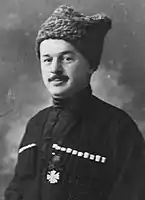 Abdulmajid Tapa Tchermoeff, oil industrialist, first chairman of the Central Committee and first prime minister, Chechen. Died in Switzerland in 1937.
Abdulmajid Tapa Tchermoeff, oil industrialist, first chairman of the Central Committee and first prime minister, Chechen. Died in Switzerland in 1937. Rashid Khan Kaplanov, second Chairman of the Central Committee, Minister of the Interior, Kumyk. Assassinated by the Bolshevik government in 1937.
Rashid Khan Kaplanov, second Chairman of the Central Committee, Minister of the Interior, Kumyk. Assassinated by the Bolshevik government in 1937.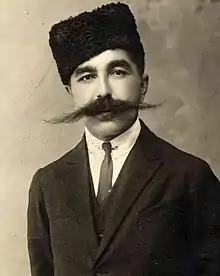
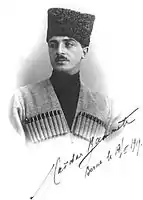 Haidar Bammate, Foreign Minister, Kumyk. Died in Paris in 1965.
Haidar Bammate, Foreign Minister, Kumyk. Died in Paris in 1965.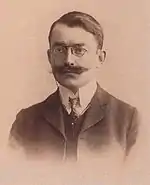 Vassan-Girey Jabagiyev, Minister of Finance, Ingush. Died in Istanbul in 1961.
Vassan-Girey Jabagiyev, Minister of Finance, Ingush. Died in Istanbul in 1961. Nukh-bek Tarkovskiy, Military Minister, Kumyk. Died in Switzerland in 1951.
Nukh-bek Tarkovskiy, Military Minister, Kumyk. Died in Switzerland in 1951.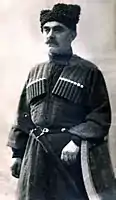 Zibair Temirkhanov, Chairman of the Madjlis (Parliament), Kumyk. Twice repressed by the Bolsheviks, died in Dagestan in 1952.
Zibair Temirkhanov, Chairman of the Madjlis (Parliament), Kumyk. Twice repressed by the Bolsheviks, died in Dagestan in 1952.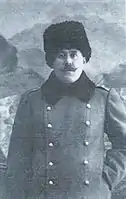 Daniyal Apashev, Member of Parliament and chairman in 1919, Kumyk. Killed by Bolsheviks in 1920.[10]
Daniyal Apashev, Member of Parliament and chairman in 1919, Kumyk. Killed by Bolsheviks in 1920.[10]
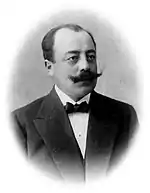
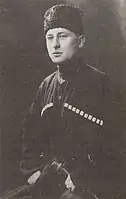 Alikhan Kantemir, the official representative in neighboring countries (Azerbaijan, Georgia), Muslim Ossetian. Died in Munich in 1963.
Alikhan Kantemir, the official representative in neighboring countries (Azerbaijan, Georgia), Muslim Ossetian. Died in Munich in 1963.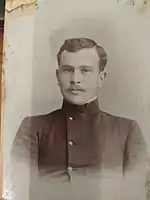 Tadjuddin Penzulayev, Minister of Justice, Kumyk. Killed by the Bolsheviks in 1937.[14] Co-author of Mikhail Bulgakov's piece "Children of Mulla".[15]
Tadjuddin Penzulayev, Minister of Justice, Kumyk. Killed by the Bolsheviks in 1937.[14] Co-author of Mikhail Bulgakov's piece "Children of Mulla".[15] Muhiddin Penzulayev, Minister of Communications, Kumyk. Died in 1942.[14] Brother of Tadjuddin Penzulayev.
Muhiddin Penzulayev, Minister of Communications, Kumyk. Died in 1942.[14] Brother of Tadjuddin Penzulayev.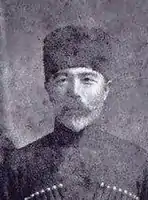 Tugan Alkhasov, member of the government, Kumyk. The circumstances of his death remain unknown.[16]
Tugan Alkhasov, member of the government, Kumyk. The circumstances of his death remain unknown.[16]
See also
 History portal
History portal- Caucasian Imamate (1828–1859)
- North Caucasian Soviet Republic (1918)
- Mountain Autonomous Soviet Socialist Republic (1921–1924)
- Confederation of Mountain Peoples of the Caucasus (1989–2000)
- Prometheism
References
- ↑ L'Europe orientale (Paris. 1919), N2
- ↑ World, Abkhaz (28 March 2009). "Abkhazia, Georgia and the Caucasus Confederation, by Stanislav Lakoba". Abkhaz World | History, Culture & Politics of Abkhazia. Retrieved 2020-03-08.
- ↑ «После Февральской революции 1917 г. процесс политического самоопределения привел к образованию Карачаево-Балкарского штата в составе горской республики.» (ИЭА Российской академии наук. Серия энциклопедий «Народы и культуры», «Карачаевцы. Балкарцы.» — М.: Наука, ИЭА РАН, 2014. — С. 7. — 815 с. ISBN 978-5-02-038043-1.)
- ↑ Петр Михайлович Шаститко (2002). Обречённые догмы: большевизм и национальный вопрос. М.: Восточная литература. p. 44. ISBN 9785020183056.
- ↑ Камалудин Гаджиев (2013). Кавказский узел в геополитических приоритетах России. Litres. ISBN 9785457145672.
- 1 2 М. Вачагаев: Союз горцев Северного Кавказа и Горская республика, 2018
- 1 2 3 Gülseven, Aslı (2021-03-30). "Büyük Güçler Yarişi Bağlaminda Başariya Ulaşmamiş Bi̇r Bağimsizlik Hareketi̇: Kuzey Kafkasya Bağimsizlik Mücadelesi̇ (1917–1920)". Nevşehir Hacı Bektaş Veli Üniversitesi SBE Dergisi. 11 (1): 245–259. doi:10.30783/nevsosbilen.873522. ISSN 2149-3871. S2CID 233912811.
- 1 2 Berzeg, Sefer E. (Mart 2003). Kuzey Kafkasya Cumhuriyeti 1917–1922, Kafkasya Dağlıları Birliği’nin Kuruluşu (I. Cilt). İstanbul : Birleşik Kafkasya Derneği.
- ↑ Doukaev 2023.
- ↑ Журнал «Ахульго, Журнал №6, Он служил своему народу.
- ↑ "Гайдаров Ибрагим-бек Исаббекович". www.hrono.ru. Retrieved 2021-02-03.
- ↑ "Газават.ру :: Личности2".
- ↑ "Ценный документ".
- 1 2 "Подвигами предков соткана наша история". Ёлдаш (in Russian). November 2019. Retrieved 2021-03-19.
- ↑ Михаил Булгаков. Фотолетопись жизни и творчества / Юрий Кривоносов. — М. : Вече, 2017. — 480 с.
- ↑ Первые государственные образования на Северном Кавказе, (май 1917 – март 1920 гг.), Какагасанов Г. И., Матиев Т. Х., Болдырев Ю.Ф., Назарова О. В., Вестник Ингушского научно-исследовательского института гуманитарных наук им. Ч.Э. Ахриева, 2019
Bibliography
- "Caucasian Republic Mission to the Peace Conference Appeal for Help", The Morning Post, London, Friday 4 April 1919.
- J. "Obedinennyi Kavkaz" ("Vereinigtes Kaukasien"), 1–3 (30–32), München, 1954. (in Russian)
- Baddeley, J. F., 1908, The Russian Conquest of the Caucasus, Longmans, Green, and Co., London
- Madeleine Henrey, Madeleine Grown Up, J. M. Dent & Sons, London, 1954.
- Kathleen R. Jackson, Marat Fidarov, Essays on the History of the North Caucasus, HHN Media, New York, 2009.
- Marshall, Alex (2010), The Caucasus Under Soviet Rule, New York City: Routledge
- Saparov, Arsène (2015), From Conflict to Autonomy in the Caucasus: The Soviet Union and the making of Abkhazia, South Ossetia and Nagorno Karabakh, New York City: Routledge
- Storozhenko (ed.), Ingushetia and Chechen Republic Map, Northern Caucasian Aerogeodesic Company of Roskartografia, Russia, 1995.
- Levan Z. Urushadze, "About the history of the question of unity of the Caucasian Peoples". J. "Amirani", XIII, Montreal‐Tbilisi, 2005, pp. 72–87.
- «Союз горцев Северного Кавказа и Горская республика. История несостоявшегося государства. 1917–1920», М.М. Вачагаев, 2018
- Doukaev, Aslan (December 2023). "Resurgent Dreams of Independence in the North Caucasus". Eurasia Daily Monitor. Jamestown Foundation. 20 (188).
